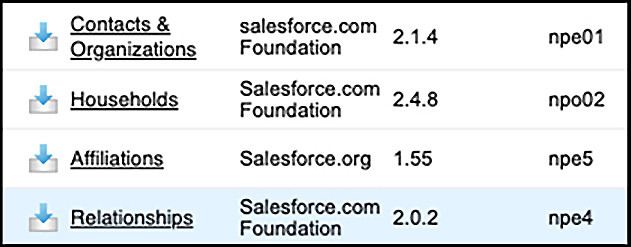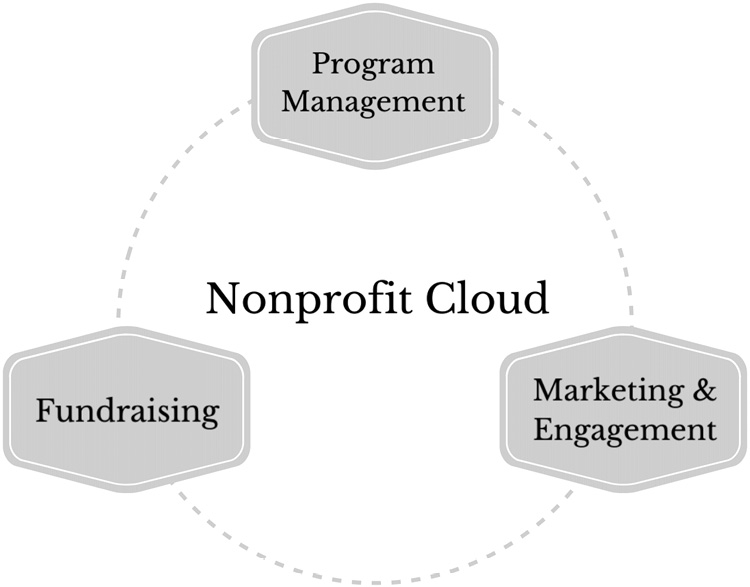The making of Nonprofit Cloud
From the very beginning in 1999, Salesforce made a commitment to nonprofits and charities around the world. That commitment encompassed 10 free Salesforce licenses provided by the Salesforce Foundation. There are geographic limitations to the 100 Enterprise license donations; see the eligibility guidelines at https://www.salesforce.org/power-of-us/eligibility-guidelines/. Although nonprofits had similar requirements around what a customer relationship management platform should do, those requirements were not always easily met within the standard Salesforce architecture that was focused on corporate use cases.
As more nonprofits began to embrace Salesforce to automate processes, implementations varied wildly and became more and more expensive to maintain. As I have worked with nonprofits, I have seen the standard Salesforce Account functionality used. However, I've also seen other iterations designed to adapt the data structure to be more useful to donors and members rather than customers. For example, the bucket model was used to accommodate individuals at one point. This was before Person Accounts were introduced by Salesforce. There was one account named Individual and, you guessed it, individual contacts were assigned to that account. As with all things Salesforce, there are limits. As a Salesforce administrator, you know that best practices recommend a maximum of 10,000 child records. Hundreds of thousands of donor or volunteer contact records, all associated with the Individual account record, can cause challenges. This was just one area that needed a solution.
Other nonprofits, with more resources, began to customize Salesforce to meet their needs. New York Cares – an early nonprofit adopter of Salesforce – hired Avviato, Inc. to help design, build, and implement a data structure very similar to what would become Nonprofit Starter Pack. In 2009, Contributor Development Partnership and roundCorner partnered to build the NGO Connect app on Salesforce. The fundraising software was used by dozens of public broadcasting stations and other nonprofits. Once again, the data structure and functionality hinted at what was to come in Nonprofit Starter Pack's initial offering. However, these early implementations make it very time-consuming and complex to migrate customers to Nonprofit Success Pack because there are so many conflicting triggers that must be resolved.
What we know today as Salesforce.org started out as the Salesforce Foundation, and, as already mentioned, they handled the donation of 10 Salesforce Enterprise licenses for any qualifying nonprofit organization as part of Salesforce's original Pledge 1% model. In 2019, Salesforce.org was acquired by Salesforce.com; so, when we refer to Salesforce.org, it is in reality a team within the larger Salesforce ecosystem.
It didn't take long to realize that nonprofits needed more than just a Salesforce instance; they needed it configured to better meet their needs. What was then known as Nonprofit Starter Pack was conceived and created as an open source application on Salesforce. It was created by volunteers and community members who were anxious to help nonprofits succeed with Salesforce. It went through a couple of iterations before it became Nonprofit Success Pack, now maintained by Salesforce.org, with minor bug-fix releases every other week as well as the three major releases per year – not bad for a free product! The following is a brief history of NPSP:

Figure 1.1 – A timeline of Salesforce's Nonprofit Success Pack
Nonprofit Starter Pack (NPSP) consisted of five separate apps – all free and open source. NPSP is important to understand because it sets the data architecture as well as the core functionality for today's Nonprofit Cloud. NPSP focuses primarily on fundraising and donor management, and includes basic reporting and analytics. Improvements to NPSP with core donation management, donor engagement, and basic reporting and analytics prompted a rebranding, and NPSP 2.0 was born and launched. The following is the way the NPSP apps originally looked in the installed packages section of the Salesforce setup:

Figure 1.2 – Original objects for NPSP
Nonprofit Success Pack (3.0) is now on AppExchange as a complete integrated suite that includes Lightning Experience as well as a robust partner ecosystem, with a great number of ways to extend the functionality of NPSP. It is the core of Nonprofit Cloud, but Nonprofit Cloud comprises so much more. Originally announced in 2018, Nonprofit Cloud is advertised as the one place to work with all nonprofit relationships (see https://www.salesforce.org/nonprofit/), using tools for fundraising, program management, and marketing and engagement:

Figure 1.3 – The three pillars of NPSP
Throughout the course of this book, we will explore, in depth, the following areas of Nonprofit Cloud:
- Nonprofit Success Pack
- Fundraising
- Program management
- Volunteer management
You will be able to ascertain when to use these tools, how to implement them, and how to configure them for the organization.
Subsequent chapters will also include learning around additional functionalities:
- Grantmaking and grants management
- Insights
- Elevate
- Accounting subledger
- Marketing and engagement
Important Note
These add-on modules may be free or paid. Some are part of the Open Source Community Sprints and others Salesforce donates to nonprofit organizations.
The other important part of Nonprofit Cloud – beyond the core architecture, packaged functionality, and configuration – is the ability to customize the functionality. Trigger Driven Management Tables (TDTM) plays an important role in Nonprofit Cloud and may be a new concept to Salesforce administrators.
We've got a lot to cover, so let's get started!



